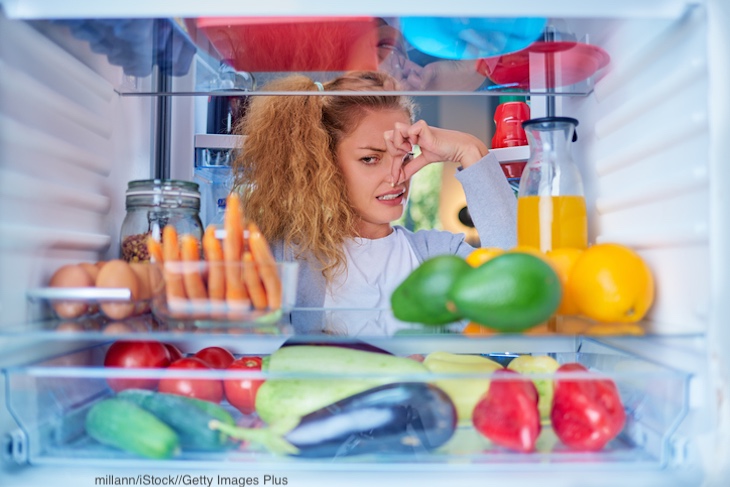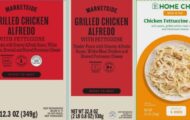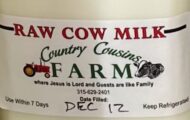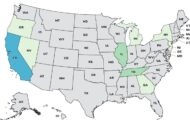We heard from the developer of the campaign and app about things the Guardian article let out. The actual campaign is much more aligned with food safety than the Guardian article would lead a reader to believe. We included their response at the end of this piece.
An article published in The Guardian a few days ago outlined a new British government initiative that could be tragic: officials are telling people to “sniff and taste” their food before discarding it. The problem with the sniff test for food safety is that pathogenic bacteria, such as Salmonella, E. coli, and Listeria monocytogenes, do not change the taste, aroma, or texture of food. And while refrigerator temperatures below 40°F slow bacterial growth, it doesn’t stop it completely.

The campaign, called “Look, Smell, Taste, Don’t Waste” is part of the food waste reduction app called Too Good To Go. Brands are being asked to switch from “use by” to “best before” dates on foods. While it’s true that some foods such as ketchup or relish are still safe to eat after that date has passed, since those dates are more about the quality of the food rather than safety, not all foods are.
The issue is that this app and the government are confusing bacteria that cause food spoilage with bacteria that cause serious illness. And that fact isn’t even mentioned in the campaign.
One chef is quoted in the article saying “Food looks and smells odd when it is no good.” While spoiled food can certainly make you sick, the most serious illnesses are caused by bacteria that do not affect the taste, smell, texture, or appearance of food.
Some people might argue that the dollar amount of food waste costs society much more than the dollar amount of food poisoning. However, death, hospitalization, and suffering from food poisoning is a much higher cost in the end.
One of the most dangerous pathogens, Listeria monocytogenes, can grow rapidly at refrigerator temperatures. If someone puts a salad, for instance, that is contaminated with a small number of Listeria monocytogenes cells, in the fridge, and leaves it there for days, the bacterial load could easily grow to an infectious dose. Then, if that salad is eaten by someone in a vulnerable population, such as an elderly person or a pregnant women, they could get very sick or even die.
Or if a pound of hamburger is left in the fridge longer than four days, and it “still smells fine,” it could be used to make burgers that are not cooked to a safe final internal temperature. Since ground beef can be contaminated with Salmonella or E. coli bacteria, this is a recipe for tragedy. Both E. coli and Salmonella can grow at refrigerator temperatures.
Chicken is another problematic food, and is one that is listed on the “Top ten most wasted food and drink items in UK homes.” It is often contaminated with Campylobacter and Salmonella bacteria. Cooking raw chicken that “smells fine” after days in the fridge could cause serious illness, especially if it is not cooked to 165°F. The “sniff test for food safety” is dangerous in this case.
Produce is another issue. There have been many food poisoning outbreaks in the past decade linked to produce. If a peach, for instance, is contaminated with Salmonella and it is left out on the counter for days, then eaten uncooked, it could contain millions of cells of Salmonella and it wouldn’t look or taste different from an uncontaminated peach.
Compounding this bad advice is the fact that most people do not use food thermometers when they cook, so some bacteria could easily survive, and the fact that some refrigerators may not be set at proper temperatures. Some fridge temperatures could be set in the danger zone above 40°F where bacteria grow rapidly. And many times perishable food is left out of refrigeration too long, which causes bacterial growth. Then when that food is finally refrigerated, it could be very unsafe to eat in a few days.
And there’s another issue. Many bacteria produce toxins as they grow that are not destroyed by heat. So even if the food is cooked properly, it could still make people sick.
Until our food safety supply can be made safe from dangerous, sometimes deadly, bacteria from farm-to-fork, take the advice of the British government with a grain of salt. Follow “use by” dates rigorously on perishable foods, especially meat and produce and always use safe food handling procedures and a food thermometer. And certainly don’t rely on your nose to discover if food is safe to eat. The sniff test for food safety is unreliable at best and potentially dangerous or even deadly at worst.
Response from Too Good To Go:
“We thought it was important to reach out to you to clarify
a few things about our campaign that may have got lost in The Guardian piece.
In research conducted earlier this month, we found that 45% of consumers in the UK do not fully understand what Best Before means. This is leading to unnecessary food waste, which is what we’re looking to change.
Our campaign is all about reducing confusion around Best Before date labels and what they mean so that produce is not being thrown away whilst it is still perfectly good to eat. Most importantly, we are looking to educate consumers that Best Before labelling is a measure of quality rather than safety – specifically on produce that has been stored correctly, and is
unopened. In fact, food labelled with Best Before dates can be still good to eat for weeks or maybe months after the date shown, providing that the packaging remains intact and storage guidance is followed.
We are working with a number of household brands to ensure that there are new calls to action included on Best Before food packaging to encourage consumers to use their senses to determine whether an unopened Best Before product is good to eat after the Best Before date shown. These labels have
been designed specifically for Best Before foods and will not appear on any Use By product.
We fully appreciate the importance of Use By labels in protecting the safety of consumers and by no means want to suggest otherwise. We are in agreement with your piece that this distinction needs to be made clear so consumers are empowered to make the correct decisions about the food that they have in their homes.
I do hope that this has helped to provide you with more detail on our campaign and its objectives.”




